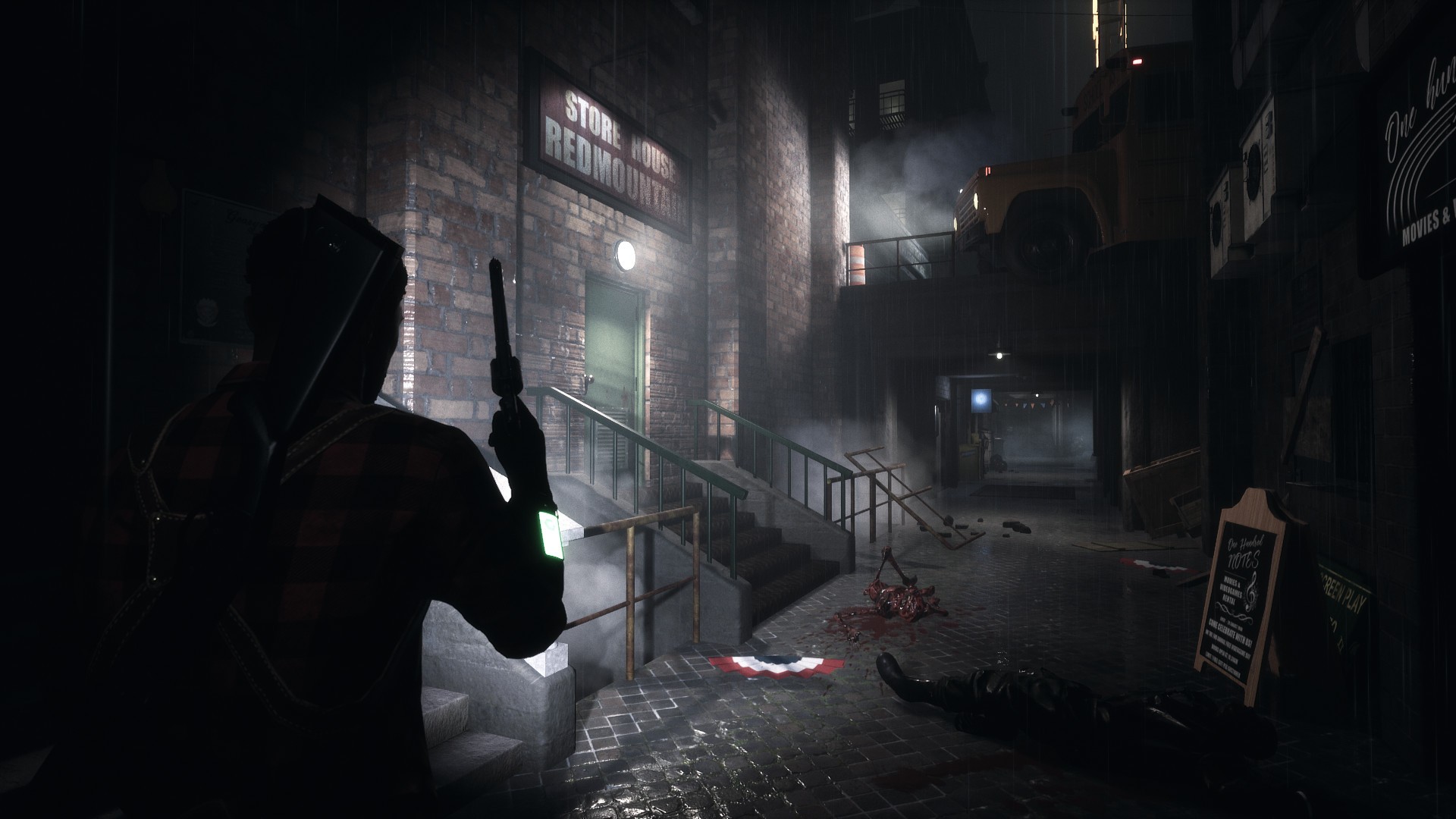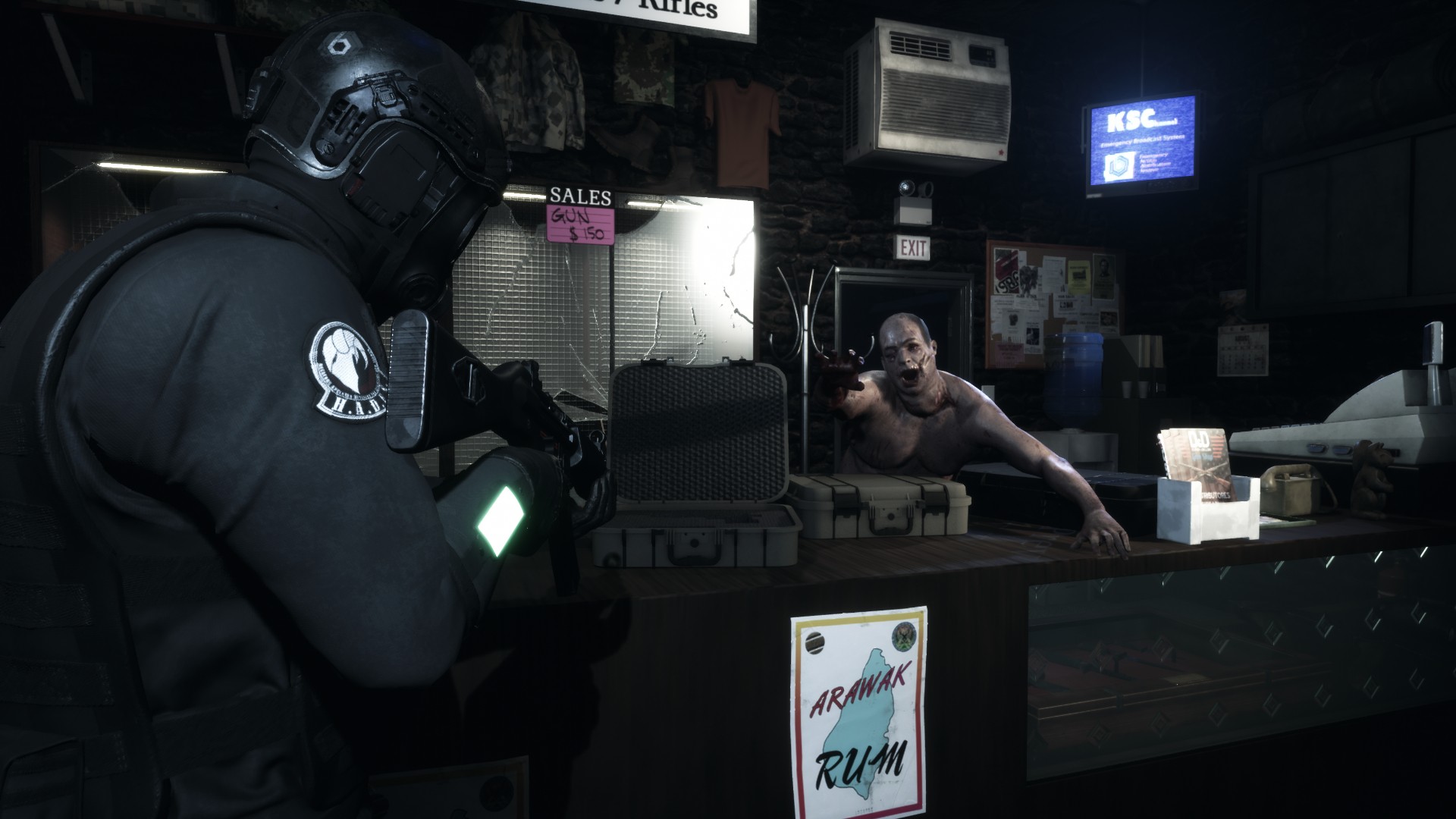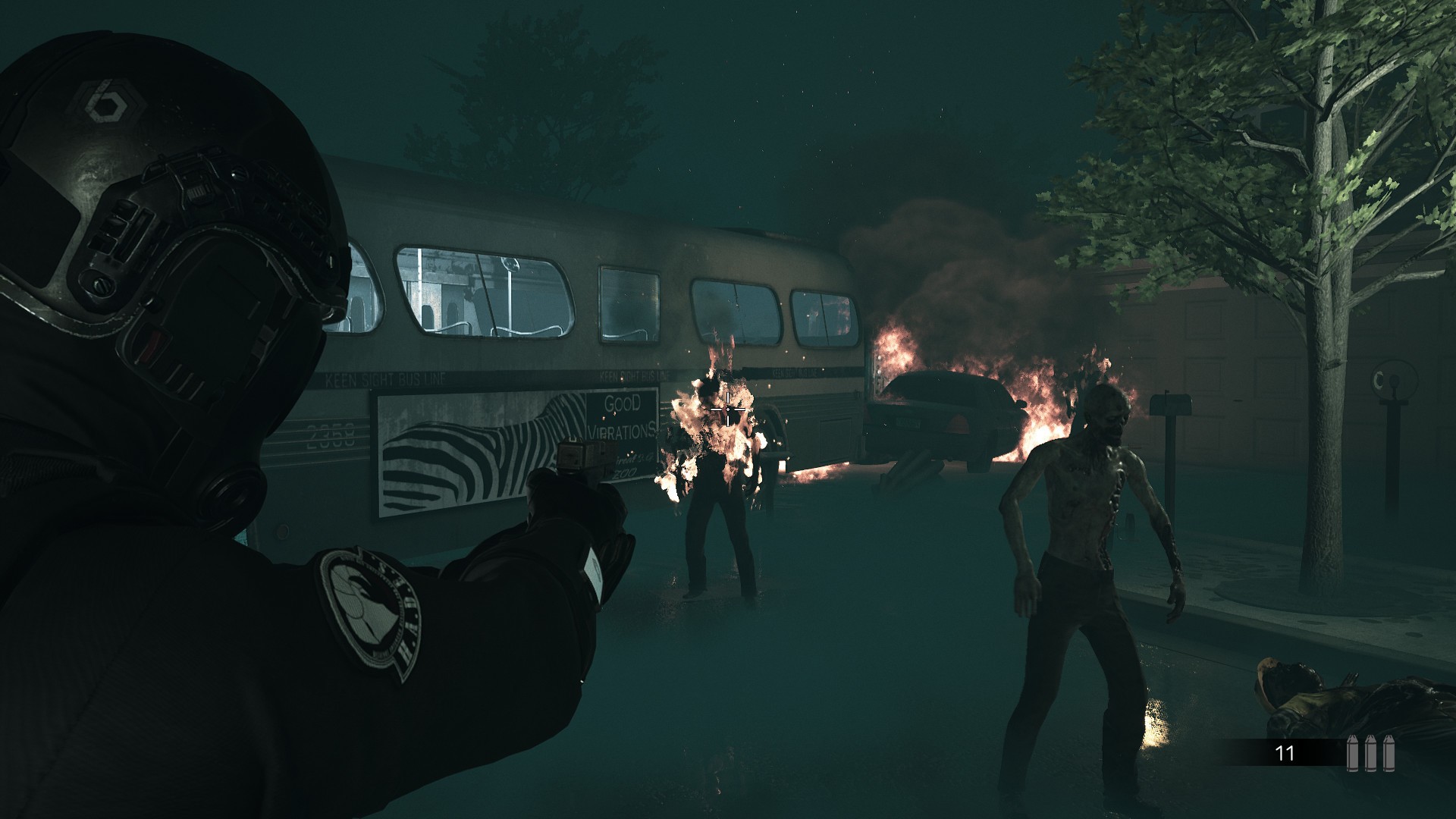
Daymare: 1998 is a hell of a mixed bag. Its interesting level design, fresh and fun mechanics, and effectively creepy atmosphere are, unfortunately, frequently squandered, either by the embarrassing plot, technical issues, or frustrating encounters.
While the core experience of exploring, puzzle-solving, and slow-paced third-person shooter gameplay is inspired by and very reminiscent of classic and recent Resident Evil (let’s not speak of the in-between), Daymare has its own unique and interesting mechanics. Much of Daymare’s HUD is neatly contextualised through the D.I.D system – in-universe a Pip-Boy like wristwatch that contains the map, inventory, and documents. It also beeps near hidden rooms, which is a neat way to find additional resources.
Through the D.I.D you manage your ammo and weapons, though Daymare provides some fresh twists on the Resident Evil formula through its reloading system. To most efficiently play Daymare, you have to find, manage, and combine not only ammo and weapons but magazines too. The process sounds taxing and it takes some getting used to but combined with its standard but satisfying arsenal of weaponry, it adds an effective new twist to the resource management process.

Unfortunately, Daymare’s mechanics towards the latter half become at odds with themselves. The ammo management process, as well as the limited movement and unreliable melee system do not work well at all with some of the encounters in the latter half. This is exacerbated both by a sudden difficulty spike in terms of resource and enemy placement, with ammo and health items becoming few and far between in areas where they are most needed. This, plus fast, durable enemies that you are either forced to kill; or might as well be due to the tight areas in which they reside, leave some encounters painful to play through. In contrast to Resident Evil, Daymare, even on the standard difficulty (which cannot be changed after starting), becomes inconsistent and poorly thought out in terms of item and enemy placement.
Daymare’s origins as a Resident Evil 2 fan remake are made obvious through some of its areas being near identical. Daymare shines brightest through its locales – including hospital wards, city streets and government facilities, which although could use some more variety in enemy threats (zombie, bigger zombie, biggest acid shooting zombie), nonetheless provide a well-crafted and interesting mixture of backtracking and continuously inventive puzzles accompanied by an enjoyable soundtrack. A notable enemy trick comes in the form of zombies, who for uninteresting plot reasons, are actually hallucinations. Having a zombie grab you, but cause no damage and then disappear, is a cool twist on proceedings, but they would be better if there was some sort of telegraph as to which are not real. As they are, it feels cheap when bullets go to waste on them. Regardless, it was in the slower, larger, and well-balanced primarily gameplay-focused sections that I found myself most invested because during these Daymare feels like a solid, authentic survival horror.
Some interesting extra lore and puzzle clues come through audio logs and notes but could have used more proof-reading, as grammatical errors and clunky writing lie throughout. Also, like Destiny’s Grimoire, many of the notes are only readable through passwords you have to enter on a separate website (which, I’ll tell you right now, I did not bother to do), which was too convoluted for Destiny and even more so here. There’s not much here in the way of replayability, other than finding all of these collectibles, additional difficulties and gunning for a higher rank (determined by time limit, number of deaths etc.). Daymare does have a couple of particularly memorable combat sequences throughout, including a penultimate boss which I wish was the final one, as it’s much more interesting and less repetitive than the final showdown actually is (and both are the same guy).

All of the good in Daymare is soured by almost everything narrative-wise. The voice acting from the get-go ranges from ‘fine’ to laughably bad, and much of it is towards the latter. The voice I found most convincing was a 10-second-long emergency broadcast, which I’m half convinced was stock audio. This is aided none by the heavy-handed, awkward and at times cringe-worthy script that reeks of bad localisation (“He’s going there, and then he’ll BE there”), plus overlong pointless cutscenes, and awfully executed plot twists. I didn’t care at all for any of Daymare’s three protagonists, so their plot developments and the unsatisfying cliff-hanger left me feeling absolutely nothing. The after-credits stinger provides some of the more interesting developments in the plot, however by then I was long past caring, as I half-listened while I started this review. While I’m a sucker for story, I honestly feel Daymare would be better served with a much more concise and to-the-point narrative that served to get you from one place to another, and nothing more. “Don’t dwell on useless chatter”, says one of the characters whose name I forget. I would agree.
A range of technical issues plague Daymare too. The camera can be stiff, and often jolts to a halt when you do a half-turn. I also found out within the first hour that if for any reason you try to spin continuously, the camera cannot handle it and will stop you suddenly facing a different way. Item and door prompts can be far too specific and difficult to grab, especially so when pursued. Some also appear when there’s nothing there; an item already picked up, a door already opened; these can make things confusing when exploring previously trekked areas. I found issues with the audio throughout, notably enemies sounding right next to me when they were rooms away, but this came to a head in the last chapter, where sound effects would frequently come seconds late or repeat like the game was crashing. The lip-syncing leaves a lot to be desired from the beginning (as do the character models), but at times towards the end someone would mouth a sentence and I would only hear it after the camera cut away.
I had issues with enemies too, like how they would glitch through doors I open into them, or how I’d get stuck on them with ample space to move into. Shooting one close enemy left my gun and shots clipping through it, especially annoying when every bullet counts. One who grabbed me got stuck in a wall and disappeared, and the final boss decided he, too, could not be bothered anymore and stopped moving while I picked up ammo (which, by that point, I appreciated). Most of these enemy or technical issues aren’t anything major on their own, but in combination, leave Daymare feeling like it needed considerably more polish before release.
Daymare: 1998 is a game I want to like more. Its atmospheric environments and clever design mechanics show that there is an effective and authentic survival horror experience in there somewhere. But, due to everything else surrounding it, ultimately Daymare overstays its welcome dramatically. By the end of my roughly ten-hour playthrough, I was avoiding and dodging enemies, not just out of necessity, but because I wanted it to end. Daymare, indeed.
REVIEW CODE: A complimentary PC code was provided to Bonus Stage for this review. Please send all review code enquiries to press@4gn.co.uk.
Subscribe to our mailing list
Get the latest game reviews, news, features, and more straight to your inbox
Thank you for subscribing to Bonus Stage.
Something went wrong.
Daymare: 1998 Review
-
Gameplay - 4/10
4/10
-
Graphics - 5/10
5/10
-
Sound - 4/10
4/10
-
Replay Value - 4/10
4/10
Overall
Summary
Daymare: 1998 doesn’t live up to its admittedly ambitious aspirations, as it’s plagued by gameplay and story issues throughout.
Pros
- Authentic survival horror level design
- Appropriate and engaging soundtrack
Cons
- Awful overstuffed plot, nothing characters
- Awkward writing, bad voice acting
- Sound, enemy glitches
- Frustrating encounters
- Excessively harsh item placement





